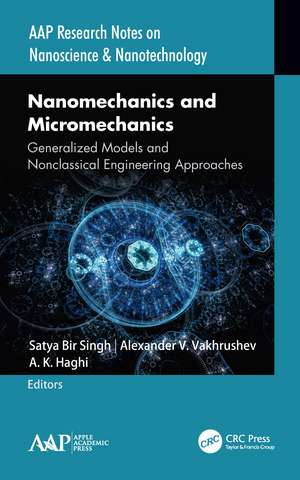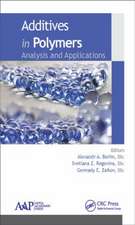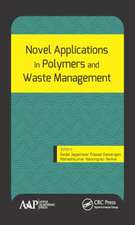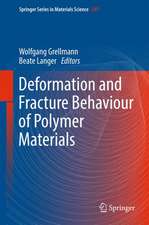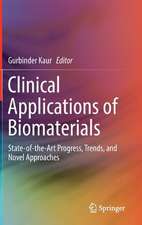Nanomechanics and Micromechanics: Generalized Models and Nonclassical Engineering Approaches
Editat de Satya Bir Singh, Alexander V. Vakhrushev, A. K. Haghien Limba Engleză Hardback – 2 iun 2020
This volume integrates various approaches in micromechanics and nanomechanics into a unified mathematical framework, complete with coverage of both linear and nonlinear behaviors. It weaves together the basic concepts, mathematical fundamentals, and formulations of micromechanics and nanomechanics into a systemic approach for understanding and modeling the effective material behavior of composite materials.
While providing information on recent developments in the mathematical framework of micro- and nanomechanics, the volume addresses highly localized phenomena and a number of interesting applications. It also illustrates application of micromechanical and nanomechanical theory to design novel engineering materials.
| Toate formatele și edițiile | Preț | Express |
|---|---|---|
| Paperback (1) | 579.62 lei 6-8 săpt. | |
| Apple Academic Press Inc. – 13 dec 2021 | 579.62 lei 6-8 săpt. | |
| Hardback (1) | 898.04 lei 6-8 săpt. | |
| Apple Academic Press Inc. – 2 iun 2020 | 898.04 lei 6-8 săpt. |
Preț: 898.04 lei
Preț vechi: 1095.18 lei
-18% Nou
Puncte Express: 1347
Preț estimativ în valută:
171.85€ • 179.65$ • 145.22£
171.85€ • 179.65$ • 145.22£
Carte tipărită la comandă
Livrare economică 07-21 martie
Preluare comenzi: 021 569.72.76
Specificații
ISBN-13: 9781771888332
ISBN-10: 1771888334
Pagini: 274
Ilustrații: 101
Dimensiuni: 152 x 229 x 20 mm
Greutate: 0.65 kg
Ediția:1
Editura: Apple Academic Press Inc.
Colecția Apple Academic Press
ISBN-10: 1771888334
Pagini: 274
Ilustrații: 101
Dimensiuni: 152 x 229 x 20 mm
Greutate: 0.65 kg
Ediția:1
Editura: Apple Academic Press Inc.
Colecția Apple Academic Press
Cuprins
1. Effects of Heat Treatment Conditions on Microstructure and Mechanical Properties of Halloysite Nanotube (HNT) Filled Epoxy Nanocomposites 2. Study of Properties of Nanostructures and Metal Nanocomposites on Their Basis 3. Possible Mechanism of Redox Synthesis of Metal/Carbon Nanocomposites Modified by P, D Elements 4. Simulation of Thermal Fields and Formation of Drops at Welding of Microsystems 5. Effect of Imposing Linear Particle Gradient on Creep Behavior in Composite Disc Having Hyperbolic Thickness 6. Microstructure and Properties of Fire-Resistant Polymeric Materials 7. Optimization of Wear Rate on the Low-Cost Reinforced-Hybrid Aluminium Metal Matrix Composite. 8. Elastic-Plastic and Creep Transition in Structural Components 9. Comparative Analysis of Elastic-Plastic Stress Distributions in Human Femur Bone, Titanium and Boron-Aluminum Fiber Reinforced Composite for Surgical Implants and Prosthetic Equipment Design 10. Creep Modeling in a Composite Rotating Disc with Constant Thickness in Presence of Residual Stress 11. Big Data Development Platform for Engineering Applications
Notă biografică
Satya Bir Singh, PhD, is Professor of Mathematics at Punjabi University Patiala in India. Prior to this he worked as an Assistant Professor in Mathematics at the Thapar Institute of Engineering and Technology, Patiala, India. He has published many research papers in journals, has given invited talks at various conferences and workshops, and has organized national and international conferences. He has been Coordinator and Principal Investigator of several government-sponsored research projects.
Alexander V. Vakhrushev, DSc, is Professor at the M.T. Kalashnikov Izhevsk State Technical University in Izhevsk, Russia. He is also the Chief Researcher of the Department of Information-Measuring Systems of the Institute of Mechanics of the Ural Branch of the Russian Academy of Sciences and Head of the Department of Nanotechnology and Microsystems of Kalashnikov Izhevsk State Technical University. He is a corresponding member of the Russian Engineering Academy. He has published monographs, articles, reports, reviews, and patents and has received several awards, including an Academician A. F. Sidorov Prize from the Ural Division of the Russian Academy of Sciences.
A. K. Haghi, PhD, is the author and editor of many books as well as of 1000 published papers in various journals and conference proceedings. Dr. Haghi has received several grants, consulted for a number of major corporations, and is a frequent speaker to national and international audiences. Since 1983, he served as professor at several universities. He the former Editor-in-Chief of the International Journal of Chemoinformatics and Chemical Engineering and the Polymers Research Journal and is on the editorial boards of many international journals. He is also a member of the Canadian Research and Development Center of Sciences and Cultures, Montreal, Quebec, Canada.
Alexander V. Vakhrushev, DSc, is Professor at the M.T. Kalashnikov Izhevsk State Technical University in Izhevsk, Russia. He is also the Chief Researcher of the Department of Information-Measuring Systems of the Institute of Mechanics of the Ural Branch of the Russian Academy of Sciences and Head of the Department of Nanotechnology and Microsystems of Kalashnikov Izhevsk State Technical University. He is a corresponding member of the Russian Engineering Academy. He has published monographs, articles, reports, reviews, and patents and has received several awards, including an Academician A. F. Sidorov Prize from the Ural Division of the Russian Academy of Sciences.
A. K. Haghi, PhD, is the author and editor of many books as well as of 1000 published papers in various journals and conference proceedings. Dr. Haghi has received several grants, consulted for a number of major corporations, and is a frequent speaker to national and international audiences. Since 1983, he served as professor at several universities. He the former Editor-in-Chief of the International Journal of Chemoinformatics and Chemical Engineering and the Polymers Research Journal and is on the editorial boards of many international journals. He is also a member of the Canadian Research and Development Center of Sciences and Cultures, Montreal, Quebec, Canada.
Descriere
The book addresses that materials and structures with small-scale dimensions do not behave in the same manner as their bulk counterparts. Once materials dimensions are reduced to the micron- and-sub-micron range, their properties are subject to significant change.
